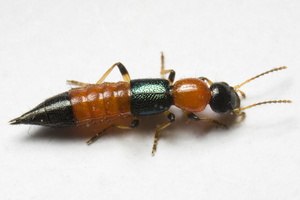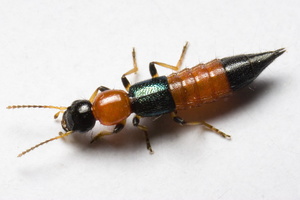- sort orderDefault
Photo title, A → Z
Photo title, Z → A
✔ Date created, new → old
Date created, old → new
Date posted, new → old
Date posted, old → new
Visits, high → low
Random - Google Map
- map
 home / Insecta · vabzdžiai / Coleoptera · vabalai / Staphylinidae · trumpasparniai / Paederus littoralis · trumpasparnis
home / Insecta · vabzdžiai / Coleoptera · vabalai / Staphylinidae · trumpasparniai / Paederus littoralis · trumpasparnis

Paederus littoralis · trumpasparnis
- Littoral Whiplash Rove Beetle
- Uferkurzflügler, Gemeiner Uferräuber
- gewone oeverkortschildkever
- żarlinek pobrzeżnik
It occurs throughout Europe north to southern Fennoscandia and the UK, extending east through Asia Minor and Russia to southern Siberia and south to North Africa and parts of the Middle East. Typical habitats include various open wetland situations; marginal habitats, marshes and flood plains. Adults occur year-round, they overwinter in the soil or among litter etc and are active over a long season from early spring, they are diurnal predators, mostly active in bright sun and often climbing plant stems but generally roaming the surface where they move rapidly and are conspicuous owing to the aposematic colouration. When handled they often adopt a threat posture with the forebody and abdomen raised, they may also secrete a defence fluid which is said to be irritating to humans, and when repeatedly disturbed they may take flight. Mating pairs occur in the spring and larvae develop through the spring and summer, in northern temperate regions there is a single generation but further south there may be several. Both adults and larvae are voracious predators known to consume large numbers of aphids and in warmer climates they are considered to be a valuable biological control agent as they may occur in very large numbers among crops, moving to headlands during harvesting and migrating back when new crops are sown. The present species is distinguished by the broad forebody and black mandibles; in other species the pronotum is at most as wide as the elytra and the mandibles are pale. 8-9mm. Head and elytra metallic blue, pronotum and abdominal segments 3-6 orange and abdominal segments 7 and 8 black. Antennae darkened from the fourth segment, palps darkened towards the apices; penultimate segment long and gradually broadened to the apex, terminal segment small and rounded. Pronotum broadest behind rounded anterior angles and narrowed to a straight basal margin, disc shiny and impunctate, posterior and lateral margins with scattered punctures and long outstanding setae. Elytra slightly elongate, with broad, rounded shoulders and almost parallel lateral margins, the surface randomly punctured and pubescent throughout. Femora bicoloured; pale from the base and dark-metallic in the apical half, tibiae mostly yellow, at most only slightly darkened at the base. Pro-tarsi yellow, meso- and meta-tarsi variously darkened towards the apices. Pro-tarsomeres 1-4 bilobed, more strongly so in the male, fourth meso- and meta-tarsomere bilobed.
About 20 Paederus species are known to have toxic chemicals (non-protein based amides with ring structure groups, named Pederin, Pseudopederin and Pederone, produced by symbiotic bacteria passed from adults to larvae via the chorion) in their haemolymph which cause contact dermatitis, and so far as is known this is the only genus within the family to do so, skin reactions are usually mild but can be severe in some people, causing extensive inflammation and peeling skin, it is usually caused by crushing beetles against the skin but cases in temperate regions are very rare.

